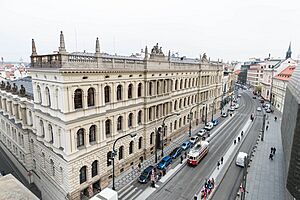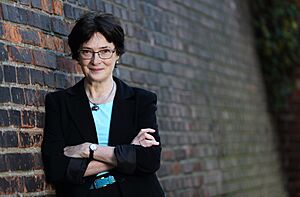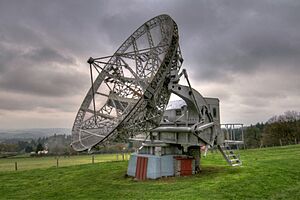Czech Academy of Sciences facts for kids
|
Akademie věd České republiky
|
|

The main building of the Czech Academy of Sciences in Prague
|
|
| Established | 1784 Royal Czech Society of Sciences 1953 Czechoslovak Academy of Sciences 1992 Academy of Sciences of the Czech Republic |
|---|---|
| President | Prof. Eva Zažímalová |
|
Administrative staff
|
7771 |
| 4395 | |
| Location |
,
50°4′54″N 14°24′51″E / 50.08167°N 14.41417°E |
 |
|
The Czech Academy of Sciences (CAS), also known as AV ČR in Czech, is a very important science organization in the Czech Republic. It was created in 1992. It took over from older science groups, some of which started way back in 1784!
The Academy is the main place for public research in the Czech Republic. Scientists here do both basic research, which helps us understand the world, and applied research, which solves real-world problems.
The CAS has three main areas of science. These include Mathematics, Physics, and Earth Sciences. They also study Chemical and Life Sciences. Plus, they look into Humanities and Social Sciences. The Academy runs 60 different research institutes. About 6,400 people work there, and more than half are highly trained scientists.
The main office of the Academy is in Prague. Many research institutes are also in Prague. Other institutes are located in different cities across the country.
Contents
History of the Academy
The Czech Academy of Sciences has a long and interesting history. It grew from several older science groups. These groups helped shape the way science is done in the Czech Republic today.
- Royal Czech Society of Doctrines (1784–1952): This was one of the first big science groups. It focused on learning and sharing knowledge.
- Czech Academy of Sciences and Arts (1890–1952): This group added arts to its focus. It showed how science and culture are connected.
- Czechoslovak Academy of Sciences (1953-1992): After World War II, this larger academy was formed. It brought together many scientific efforts.
In 1992, the current Czech Academy of Sciences was created. It continued the important work of these earlier organizations. In 2010, the Academy decided to make its research free for everyone to read. This is called an open access policy. It means more people can learn from their discoveries.
What the Institutes Do
The Czech Academy of Sciences has many different institutes. These institutes are grouped into three main areas. Each area has smaller sections. Each section then has several institutes. These institutes are where scientists do their research. They might have departments, labs, or special teams.
Studying Inanimate Nature
This area focuses on things that are not alive. It includes subjects like space, numbers, and how things work.
Mathematics, Physics, and Computers
- Astronomical Institute: Scientists here study stars, planets, and the universe. It was founded in 1954.
- Institute of Physics: This institute explores how energy and matter behave.
- Institute of Mathematics: Researchers here work on numbers, patterns, and solving complex problems.
- Institute of Computer Science (ICS): This group studies how computers work and how to use them better.
- Nuclear Physics Institute: They research the tiny parts that make up atoms.
- Institute of Information Theory and Automation (UTIA): This institute, started in 1959, looks at how information is processed and how systems can control themselves.
Applied Physics Research
This section uses physics to create new technologies and understand everyday things.
- Institute of Photonics and Electronics: They work with light and electronic devices.
- Institute of Physics of Materials: Scientists here study how different materials behave.
- Institute of Plasma Physics: This institute researches plasma, which is a super-hot state of matter.
- Institute of Hydrodynamics: They study how liquids and gases move.
- Institute of Scientific Instruments: This group designs and builds tools for science.
- Institute of Thermomechanics: They study heat and how forces affect things.
- Institute of Theoretical and Applied Mechanics: This institute looks at how things move and bend.
Earth Sciences Research
This area is all about our planet Earth.
- Institute of Geophysics (GFÚ): Founded in 1920, this institute studies earthquakes and the Earth's structure.
- Institute of Geology: They research rocks, minerals, and how the Earth has changed over time.
- Institute of Atmospheric Physics: Established in 1964, this group studies weather and the Earth's atmosphere.
- Institute of Geonics: They look at how humans interact with the Earth's surface.
- Institute of Rock Structure and Mechanics: This institute studies how rocks behave under stress.
Life and Chemical Sciences
This area focuses on living things and the chemicals that make them up.
Chemical Sciences Research
- Institute of Inorganic Chemistry: They study chemicals that don't contain carbon.
- J. Heyrovský Institute of Physical Chemistry: Named after Jaroslav Heyrovský, this institute studies how chemicals react. It was formed in 1972.
- Institute of Chemical Process Fundamentals: Founded in 1960, this group looks at how chemical factories work.
- Institute of Analytical Chemistry: They figure out what chemicals are in different substances.
- Institute of Macromolecular Chemistry: This institute studies very large molecules, like plastics.
- Institute of Organic Chemistry and Biochemistry: They research chemicals found in living things.
Biological and Medical Sciences Research
- Institute of Biophysics: This institute uses physics to understand living systems.
- Biotechnology Institute: They use living organisms to create new products or solve problems.
- Institute of Physiology: This group studies how the body works.
- Institute of Microbiology: They research tiny living things like bacteria and viruses.
- Institute of Experimental Botany: This institute studies plants and how they grow.
- Institute of Experimental Medicine: Scientists here do research to improve human health.
- Institute of Molecular Genetics: They study genes and how they control life.
- Institute of Animal Physiology and Genetics: This group researches how animals' bodies work and their genes.
Biological and Ecological Sciences Research
- Biology Centre: This is a large center for many types of biology research.
- Institute of Botany: They study plants and plant life.
- Institute of Vertebrate Biology: This institute focuses on animals with backbones.
- Institute of Systems Biology and Ecology: They look at how living things interact with their environment.
Humanities and Social Sciences
This area explores human society, history, and culture.
Social Sciences and Economy Research
- Economics Institute (EI): This institute studies how money and resources are used in society. It includes the Center for Economic Research and Graduate Education (CERGE), founded in 1991.
- Institute of Psychology: They research how people think and behave.
- Institute of Sociology: This group studies human societies and how they are organized.
- Institute of State and Law: They research how governments work and the rules of society.
History Research
- Institute of Archaeology (Prague and Brno): These institutes dig up and study old objects to learn about the past.
- Institute of History: They research past events and people.
- Masaryk's Institute and Archives: This group studies the life and work of important historical figures.
- Institute of Art History: They research the history of art and architecture.
- Institute of Contemporary History: This institute focuses on more recent historical events.
Humanities and Philosophy Research
- Institute of Ethnology: They study different cultures and traditions.
- Institute of Philosophy: This institute explores big questions about life and knowledge. It has a special department for Medieval Studies.
- Oriental Institute: This group studies the cultures and languages of Asia and Africa.
- Institute of Slavonic Studies: They research the languages and cultures of Slavic countries.
- Institute of Czech Literature: This institute studies books and writings from the Czech Republic.
- Institute of Czech Language: Founded in 1946, this group studies the Czech language itself.
See also
- Amalka Supercomputing facility



